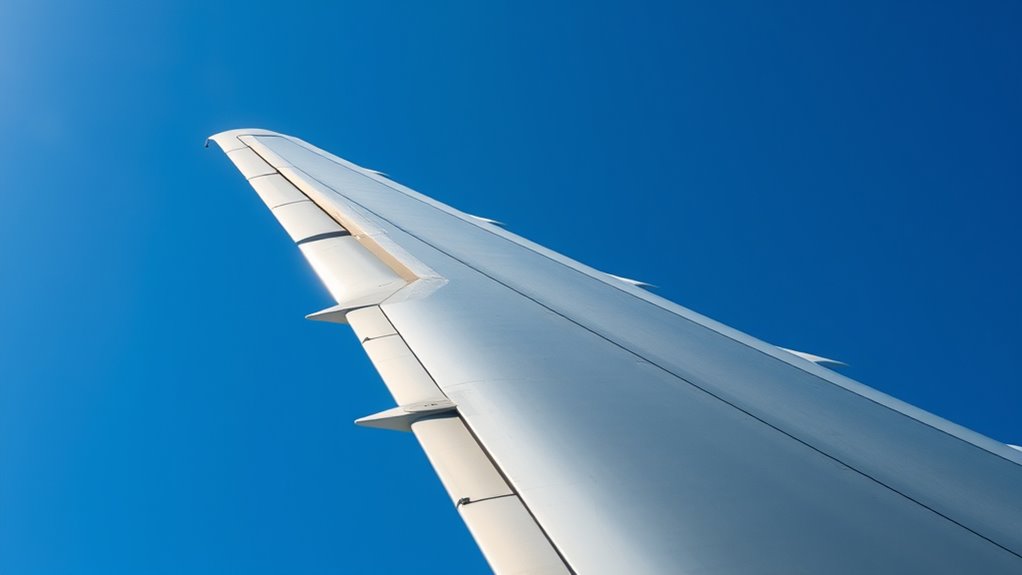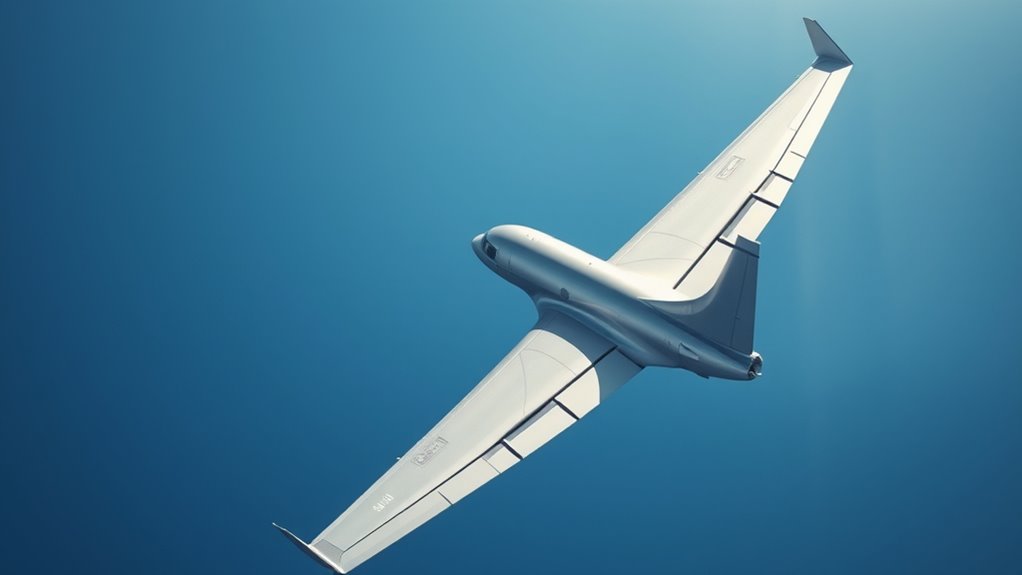To reduce induced drag with subtle flap adjustments, you should fine-tune the flap angles to optimize airflow over the wing. Slightly changing flap positions can weaken vortex formation and improve boundary layer flow, which lessens turbulence and drag. By making small, controlled moves, you can enhance aerodynamic efficiency and stability during flight. If you keep adjusting carefully, you’ll discover even more ways to improve performance and safety through precise flap management.
Key Takeaways
- Slight flap angle changes optimize boundary layer flow, reducing wingtip vortices and decreasing induced drag.
- Fine-tuning flap positions enhances vortex suppression, leading to improved aerodynamic efficiency.
- Subtle adjustments help manage airflow over the wing, minimizing turbulence and vortex strength.
- Proper flap settings during critical phases lower vortex-induced drag, boosting overall aircraft performance.
- Precise flap modifications promote better vortex control, resulting in fuel savings and increased flight safety.
Understanding the Role of Flaps in Aerodynamics

Understanding the role of flaps in aerodynamics is essential because they considerably influence an aircraft’s lift and drag characteristics. Historically, aircraft used simple flap designs made from durable materials like metal and fabric to improve takeoff and landing performance. Over time, advancements in flap materials, such as composites and lightweight alloys, allowed for more effective and reliable flap operation. These materials help reduce weight and increase durability, enabling pilots to deploy flaps more precisely. Flaps work by altering the wing’s surface area and curvature, which increases lift at lower speeds. Their design and material choice directly impact how efficiently they perform, ultimately affecting the aircraft’s overall aerodynamic profile during critical phases of flight. Understanding these elements helps you appreciate how flap technology evolved to optimize aircraft performance. Additionally, modern flap systems benefit from innovations in material technology, which further enhance their efficiency and reliability during flight operations.
How Flap Angle Adjustments Affect Lift and Drag

Adjusting the flap angle directly impacts both lift and drag, as increasing the flap deflection changes the wing’s surface shape and airflow behavior. When you deploy flaps, the increased surface curvature generates more lift but also raises induced drag. The flap material influences how smoothly and reliably these adjustments occur, affecting overall aerodynamic efficiency. Flap manufacturing quality ensures precise control and durability, which are vital for subtle adjustments that reduce drag. Here’s a quick comparison:
| Flap Setting | Lift Effect | Drag Effect |
|---|---|---|
| Slight increase | Moderate lift | Slight drag increase |
| Moderate increase | Significant lift | Noticeable drag rise |
| Full extension | Max lift | High drag |
Understanding these effects helps you fine-tune flap angles to optimize performance and minimize induced drag. Proper manufacturing quality ensures that the flap mechanisms perform reliably during subtle adjustments.
Identifying Optimal Flap Settings for Minimizing Induced Drag

To identify the most favorable flap settings for minimizing induced drag, you need to analyze how different angles affect overall aerodynamic efficiency. Subtle flap adjustments influence wingtip vortices, which are a primary source of induced drag. Ideal flap positions help reduce vortex strength, decreasing drag and improving performance. Pay close attention to the boundary layer, as excessive flap deflection can cause flow separation, increasing drag instead of reducing it. The goal is to find a balance where the flap angle is enough to smooth airflow over the wing surface without disturbing the boundary layer or intensifying wingtip vortices. By carefully testing and observing these effects, you can pinpoint the flap setting that minimizes induced drag and enhances aerodynamic efficiency during cruise. Incorporating expert voice actors or specialized soundscapes in training materials can also improve understanding of aerodynamic concepts.
Techniques for Gentle Flap Deployment During Cruise

When deploying flaps during cruise, gentle and controlled movements are essential to maintain aerodynamic stability and minimize induced drag. Use smooth, gradual adjustments rather than quick changes, ensuring the airflow remains steady. Pay attention to your flap material; some composites or metal surfaces respond better to subtle movements, reducing stress and preventing damage. Regular maintenance procedures help keep the flap system responsive and in excellent condition, which is vital for delicate deployment. Check for any play or irregularities in the hinge mechanisms before flight, and lubricate moving parts as recommended. Proper handling and routine upkeep ensure your flaps operate smoothly, allowing you to fine-tune their position without disrupting airflow or increasing drag. Using the right oil for your flap system can further enhance performance and longevity. This approach supports efficient cruise performance with minimal aerodynamic penalties.
The Impact of Flap Position on Airflow and Efficiency

Your flap position directly affects airflow over the wing, influencing lift and drag. Adjusting the flap angle can optimize efficiency by managing airflow patterns more effectively. Small changes in flap settings can lead to significant gains in overall flight performance. Additionally, understanding how airflow management impacts lift and drag is essential for fine-tuning flight dynamics.
Flap Angle and Airflow
Have you ever wondered how the position of flaps influences airflow over an aircraft’s wings? Adjusting flap angles subtly impacts airflow patterns, which can reduce wingtip vortices and minimize flap flutter. When you change the flap angle, you alter how air moves over the wing surface, affecting lift and drag. Small adjustments can smooth airflow, decreasing turbulence and vortex strength. Proper flap positioning helps prevent unstable airflow that causes wingtip vortices, which contribute to induced drag. Additionally, it reduces the risk of flap flutter by maintaining steady airflow and pressure distribution. Being mindful of flap angle during flight lets you optimize airflow, improving overall efficiency and safety without dramatic modifications. The right adjustments make a significant difference in airflow stability and aircraft performance. Kia Tuning techniques often focus on fine-tuning components to enhance efficiency, much like subtle flap adjustments optimize airflow in aviation.
Efficiency Gains From Adjustment
Adjusting flap positions can substantially enhance an aircraft’s efficiency by optimizing airflow over the wings. When you fine-tune flap settings, you influence how airflow interacts with the wing surface, reducing wingtip vortexes that create induced drag. Subtle flap adjustments can smooth airflow, lowering vortex strength and improving lift-to-drag ratios. Additionally, flap material selection plays a critical role; lightweight, durable materials allow for precise, responsive adjustments that maximize efficiency gains. By carefully controlling flap angles, you can minimize turbulence and vortex formation at the wingtips, which directly reduces induced drag. This not only improves fuel economy but also enhances overall flight performance. Proper tuning techniques can further optimize flap performance for maximum efficiency. Small, intentional modifications to flap position, coupled with smart material choices, lead to significant efficiency improvements during flight.
Practical Tips for Fine-Tuning Flaps in Real-Time Flight

Fine-tuning flaps during flight requires careful attention to how they affect your aircraft’s performance. Subtle adjustments can markedly reduce induced drag and improve turbulence control, especially around wingtip vortices. To optimize flap settings in real-time:
- Watch for changes in yaw or roll, indicating vortex interference.
- Use small, incremental flap adjustments rather than large changes.
- Monitor airspeed and attitude to maintain smooth airflow.
- Avoid excessive flap deflection near turbulence-prone areas to prevent unnecessary drag.
- Be aware of aerodynamic efficiency principles to effectively manage lift and drag during flap adjustments.
Case Studies Demonstrating the Benefits of Subtle Flap Changes

By examining case studies, you’ll see how small flap adjustments can boost fuel efficiency and improve flight stability. These subtle changes also help reduce wing vortices, making flights safer and more comfortable. Understanding these benefits can encourage you to fine-tune your approach for peak performance. Additionally, optimizing flap settings is essential for maintaining aircraft safety during various flight conditions.
Enhanced Fuel Efficiency
Even subtle changes to flap settings can markedly boost fuel efficiency, as demonstrated by various case studies. By optimizing flap angles, pilots reduce wingtip vortices, which minimizes induced drag and conserves fuel. Careful adjustments also lessen flap fatigue, extending component life and maintaining aerodynamic performance. In practice, small flap tweaks have led to noticeable fuel savings on long flights, especially when pilots fine-tune settings for specific conditions. These adjustments not only cut costs but also decrease environmental impact. Additionally, understanding aerodynamic principles helps pilots make informed decisions about flap modifications to enhance overall efficiency.
Improved Flight Stability
Subtle flap adjustments can considerably enhance flight stability, as demonstrated by multiple case studies. By fine-tuning flap angles, pilots report improved control during stall recovery, making it easier to regain steady flight. These small changes also help mitigate turbulence effects, smoothing out sudden jolts and maintaining aircraft balance. In one case, a slight increase in flap deflection during turbulent conditions prevented over-rotation and kept the aircraft on a stable flight path. Such adjustments allow for more precise handling, reducing pilot workload and increasing passenger comfort. Overall, these subtle flap tweaks provide a noticeable boost in stability, especially in challenging conditions, by fine-tuning aerodynamic forces and promoting safer, more controlled flights.
Reduced Wing Vortices
Adjusting flap angles slightly can considerably reduce wing vortex strength, which in turn minimizes induced drag and improves overall efficiency. By fine-tuning flap settings, you influence the boundary layer flow, leading to better vortex suppression. This reduction in vortex strength decreases the wing’s induced drag, enhancing fuel economy and flight performance. Case studies show that subtle flap adjustments can notably lessen wing vortices, especially during critical phases like takeoff and landing. These small changes help control the airflow, preventing excessive vortex formation. As a result, your aircraft experiences less turbulence and drag. Effective vortex suppression through minor flap tweaks not only improves efficiency but also enhances safety and handling, proving that sometimes, less is more when it comes to aerodynamic optimization.
- Optimized boundary layer management reduces vortex formation
- Subtle flap changes lead to measurable vortex suppression
- Less vortex strength means lower induced drag
- Improved efficiency and safety through small adjustments
Frequently Asked Questions
How Do Flap Adjustments Influence Aircraft Fuel Efficiency?
You can improve aircraft fuel efficiency by adjusting your flaps, which influences aerodynamic efficiency. Proper flap settings help reduce wingtip vortices, minimizing induced drag. When you optimize flap angles, you decrease turbulence and drag around the wingtips, leading to smoother airflow. This results in lower fuel consumption, making your flight more economical. Small, strategic flap adjustments are key to controlling induced drag and enhancing overall aerodynamic performance.
Can Subtle Flap Changes Improve Overall Flight Handling?
You can improve overall flight handling by making subtle flap adjustments, which influence aerodynamic effects positively. These small changes help optimize lift and drag balance, giving you more precise control during various flight phases. Proper pilot training is essential to understand and execute these adjustments effectively, ensuring smooth handling and safety. By mastering these techniques, you enhance your ability to respond to changing conditions and improve your aircraft’s overall performance.
What Are the Risks of Improper Flap Adjustments During Cruise?
Think of improper flap adjustments during cruise as trying to steer a ship through choppy waters with a loose rudder. You risk confusing pilot communication and disrupting maintenance procedures, which could lead to uneven airflow, increased drag, or even structural stress. These errors can compromise your aircraft’s stability, fuel efficiency, and safety. That’s why precise, well-informed flap handling is essential to keep your flight smooth and secure.
How Do Flap Settings Vary Across Different Aircraft Types?
You’ll find that flap settings vary widely across aircraft types due to differences in wing design and control surface configurations. For smaller planes, flaps often extend more to enhance lift during takeoff and landing. In contrast, larger commercial jets use more subtle flap adjustments to optimize performance and fuel efficiency. Always consider your aircraft’s specific control surfaces and wing design, as these factors dictate the appropriate flap settings for safe, efficient operation.
Are There Automated Systems to Optimize Flap Positions in Real Time?
Did you know that over 60% of modern aircraft now use automated systems for flap management? You’ll find autonomous control systems that optimize flap positions in real time, improving efficiency and safety. These systems constantly analyze flight data, adjusting flaps seamlessly to reduce drag and fuel consumption. So, yes, real-time optimization through autonomous control is increasingly common, helping pilots focus on navigation while technology fine-tunes aerodynamic performance automatically.
Conclusion
By making subtle flap adjustments, you can trim the wings of inefficiency and sail smoother through the skies. Think of your flaps as the fine-tuned strings of a guitar—small tweaks can create harmony or discord. When you master gentle, precise changes, you reveal better airflow and reduced induced drag, turning your flight into a graceful dance rather than a turbulent storm. Keep fine-tuning, and watch your efficiency soar like a bird in perfect glide.
With a heart that soars as high as the skies, Aria, affectionately known as “Skylark,” is the driving force behind Soaring Skyways. Her journey into the gliding world began as a young dreamer gazing up at the soaring birds, yearning to experience the weightlessness and freedom they embodied. With years of experience both in the cockpit and behind the scenes, Aria’s commitment to the gliding community is unwavering.









